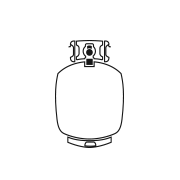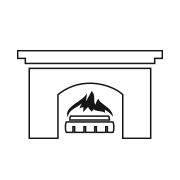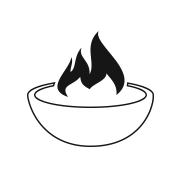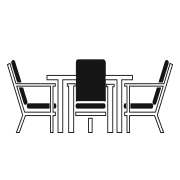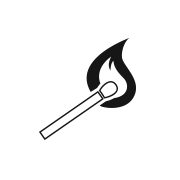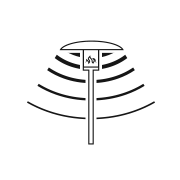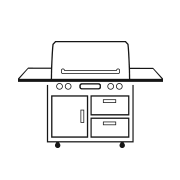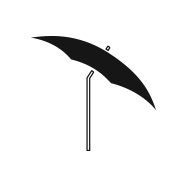Fireplaces
Real Fyre Vent-Free Ignition Options Explained
Key Words:
Standing Pilot (aka Safety Pilot): Contains a small flame that stays lit while your fireplace is not in use. This prevents you from having to light your fireplace burner with a match or lighter every time you use it. If your pilot light is extinguished for any reason, the flow of gas will be shutoff automatically to prevent harmful gas leaks. Standing pilot can be left on year round, or turned off in the off-season if preferred.
Non-Standing Pilot (aka Electronic Pilot): Does not require a flame to be lit when your fireplace is not in use. Most electronic pilot kits have flame-sensing pilot activation that allow you to light your fireplace burner with the touch of a button from your wireless remote. Because there is no standing pilot, the pilot is only lit when your fireplace is in use.
ON/OFF Remote: Controls basic on/off functionality only.
Variable Remote: Controls the basic on/off functionality as well as your flame height.
Real Fyre Ignition Control Options:
Match Lit (Only available for Natural Gas): Contains no pilot light. With every use, you will need to manually turn up your gas (usually with a manual key valve or other handle) and light the burner with either a match or long lighter. Control your gas flow manually. Match Lit ignition does not include a remote control.
"12" Series Standing Pilot (12M): This standing pilot kit allows you to control the basic on/off functionality of your burner. You will not be able to control the height of your flame with this ignition control. Remote control (sold separately) is available for purchase.
"15" Series Standing Pilot (APK-15): This standing pilot kit allows you to control the basic on/off functionality as well as the variable flame height of your burner. Remote control (sold separately) is available for purchase.
What are my upgrade options?
Which PSI do I need?
PSI, or pounds per square inch, is the unit of measure used for gas pressure. This influences the BTU output of your fire pit or fireplace. The greater the gas pressure, the higher the BTU output--and vice versa.
To ensure your safety, it is important to determine the gas pressure you are working with so that you may choose the correct AWEIS properly configured to suit your needs. For instance, features utilizing a 2 PSI gas pressure will require a smaller gas orifice to reduce gas flow. If you're still unsure of your setup's PSI requirements, we recommend reaching out to your local professional installer.
What size gas logs should I select?
The size of the gas logs you select will depend on the size of your fireplace burner. Once you have measured your fireplace and have determined what the right size burner is, the below chart can be used to select the compatible log size:

Should I choose fire glass or logs for my electric fireplace?
What are panels in an electric fireplace?
What are my options for gas fireplace controls?
When purchasing a gas burner system for your fireplace, you will find that you have an abundance of options for ignition and controls. These options may seem confusing at first, but the choices essentially come down to your ignition source and how much control you will have over the flame.
Match Lit (Only available for Natural Gas): For manual match lit burner options, there is no standing pilot light (a standing pilot light is a flame that stays lit while your fireplace is not in use). Every time you want to light your fireplace, you will need to manually turn up your gas (usually with a manual key valve or other handle), and light the burner with either a match or long lighter. The only control you will have over your flame is to manually control how much gas is getting to your burner by turning the key (or handle), thereby roughly controlling the size of the flame and allowing you to turn off the gas and flame completely.
Safety Pilot System or Standing Pilot (Available for Natural Gas or Liquid Propane): A safety pilot kit is a type of standing pilot light. If for any reason your pilot light is extinguished (due to wind, a draft, etc), the safety pilot system will automatically stop the flow of gas from your fireplace pipes. This safety mechanism will prevent gas from flowing into your house. Some automatic safety pilot kits come with a remote and receiver to allow for wireless control of your flame height, heat output, and pilot light. Basic safety pilot kits have three settings:
OFF: Turn the knob to this setting to extinguish your pilot light.
PILOT: This setting will keep your pilot light lit for ease of use (this setting is also used to light your pilot).
ON: Turn the knob to this position when you would like to use your fireplace, and gas will be sent to ignite your burner.
Electronic Pilot System or Non-Standing Pilot (Available for Natural Gas or Liquid Propane): An electronic pilot system does not have a standing pilot. Most electronic pilot kits have flame-sensing pilot activation, and allow you to light your fireplace burner with the touch of a button from your wireless remote. Because there is no standing pilot, the pilot is only lit when your fireplace is in use.
What is an ODS pilot?
Does max efficiency equal max heat?
What is a "ventless" gas heating product?
What does an outside air kit do and do I need one?
How much maintenance should I expect from my fireplace?
What are gas logs?
Can I vent my fireplace through a wall?
Showing items 1-14 of 14.





































